Breaking Ground in Sustainability: How Salt-Tolerant Rice is Reviving China’s Barren Lands
At China West Connector (CWC), we continue to track groundbreaking innovations that reshape industries and communities alike. One of the most phenomenal advancements in recent years has been the development of salt-tolerant rice, a solution poised to transform vast stretches of previously unproductive land into fertile agricultural fields.
What is Salt-Tolerant Rice?
This innovative rice variety, often called seawater rice, was developed to grow in saline-alkaline soils, which have high salt content and are typically inhospitable to most crops. Pioneered by Chinese researchers, including the renowned “father of hybrid rice,” Yuan Longping, this rice has been specifically engineered to thrive in regions where other vegetation struggles.
Phenomenal Impact
China has 1.5 billion mu (about 100 million hectares) of saline-alkaline land, with 500 million mu deemed suitable for agricultural reclamation. The development of salt-tolerant rice is poised to tap into this untapped resource. The rice has already shown tremendous success, especially in regions like Xinjiang, where yields of up to 8.6 tons per hectare were recently recorded.
Why is This Rice Revolutionary?
Food Security: China faces a growing need to ensure food security for its 1.4 billion citizens, especially in the context of shrinking arable land. Salt-tolerant rice can turn previously barren, saline soils into productive farmland, directly contributing to the nation’s food supply.
Environmental Restoration: One of the most extraordinary features of salt-tolerant rice is its ability to help restore soil. By absorbing salts and improving soil structure, it turns unproductive land into fertile fields. This rice doesn’t just produce food; it heals the land, preventing further desertification and enhancing soil health for future generations.
Economic Empowerment: Regions previously dependent on herding or struggling with desertification, such as Akto County in Xinjiang, have seen transformative economic impacts. Local farmers and nomadic herders are now able to engage in rice cultivation, providing new sources of income and diversifying regional economies.
Global Implications
China’s advancements in salt-tolerant rice aren’t just beneficial domestically. With global food security concerns on the rise, the ability to turn barren land into productive farmland has captured international attention. African and Middle Eastern nations, grappling with similar soil challenges, are collaborating with China to adopt this technology.
What Does This Mean for CWC’s Global Network?
At CWC, we are always at the forefront of linking Western enterprises with cutting-edge Chinese innovations. The development of salt-tolerant rice opens up new opportunities for agricultural technology partnerships and investments. These advancements not only enhance food security but also align with sustainable development goals globally.
As we continue to foster collaborations across industries, this technology presents a powerful case for investing in agricultural innovation in China and beyond. Stay tuned to CWC News for more updates on transformative technologies reshaping industries worldwide.


